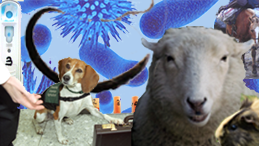
ANSC20003 Topics in Animal Health
Prac 1: Mastitis Diagnostics
Prac 1: Mastitis Diagnostics

Method: Gram Stain
Reagents and equipment for the Gram test
- Locate all the reagents and water bottles before you begin steps as there won’t be time to find them once you begin the procedure. Locate the Gram Stain Rack (a foil container with insets to hold the slide).
- Wave a slide through the bunsen burner flame several times to evaporate any moisture or oil.
- Using a marker pen write an identifying title (e.g. Sample A) on the outer section of the slide. Leave room to hold the slide as well.
- Place a small drop of water onto the middle of the slide.
- Flame a wire loop to sterilise it then let it cool.
-
With the loop, take a small colony (or part of a big one) from the Blood agar plate (AESS) and mix it with the water drop thoroughly and spread the mixture out to cover about half the slide.
Important: don’t make the emulsion too thick! -
Heat-fix the bacteria by passing it through a Bunsen burner flame in a circular motion. If it is not sufficiently heat-fixed it will come off the slide during the staining process.
When heat fixing the bacteria it is important that the slide does not become too hot as it will “fry” the bacteria. Do not use the blue tongs to hold the slide. Hold the slide with your fingers. Wave the slide through the flame three times and then rest the slide on the side of your other hand; repeat until it is completely dry. This process allows the slide to cool down between sweeps and allows you to monitor how warm it is. You need to time the following steps accurately. You can use the timer on the iPad. This is a process that is easier if you are working in pairs. - Working over a gram Stain Rack, cover the smear with Gram Crystal Violet for 10 seconds.
-
Pour off the stain and gently rinse with water (from the water bottle) until the smear runs clear.
The purpose of this step is to remove the residual crystal violet, not the smear, so do not use excessive water pressure. - Cover the smear with the Gram Iodine solution. Let stand for 10 seconds then gently rinse with water for 5 seconds. Gently shake or blot the excess water off the slide.
- Holding the slide on a 45o angle, add 4-8 drops of Gram Decolouriser until the colour of the solution running off the end of the slide is clear. This should take less than 10 seconds. If you decolourise for longer you will wash out the crystal violet and possibly get an incorrectly stained Gram + organism. Gently rinse with water for 5 seconds. Gently shake or blot the excess water off the slide.
- Holding the slide horizontally, cover the smear with Gram Safranin for 10 seconds then gently rinse with water for 5 seconds.
- Shake off any excess water and air-dry the slide. This will take about 5 minutes.
- When the slide is completely dry, examine the smear under the microscope. Focus using the low power (10x) objective. Once you’ve located the smear, place a small drop of microscope immersion oil on the slide and turn to the 100x objective (oil immersion lens). As the 100x lens makes contact with the oil drop it will “grab hold of” the lens through surface tension. If you are unsure of how to use the microscope (or the oil emersion process), ask a demonstrator for assistance. After preparing the smear, incorrect use of the microscope could damage the smear (and microscope!) and you’ll have to start again.
- Identify your bacteria as either Gram positive (+: purple) or negative (-: pink-red) based on the cell wall colour. Record your observations (Table 1). Be sure to look at the slides your prac partners have stained to see if you can determine differences from your own slide.
- Describe the morphology of the bacteria.
- Shape: cocci (round), bacilli (rod-shaped/rectangular), vibrios (definitely curved rods), spirilla (spirilla), spirochaetes (spiraled: long, thin flexible)
- Formation: If they are gram + cocci: diplo (paired), strepto (in lines), staphylo (in bunches) Presence of spores: thick non-staining swellings in the bacilli.
- Record your observations in the table.
Performing a Gram Stain: fixing the slide (video)
Performing a Gram Stain: staining (video)